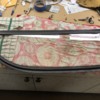I've gotten several messages from people wanting to know just how different my side windows are and why?
Well, my Vintage convertible top was ordered separately and didn't come with side windows so I used the window mounting hardware I got with my CMC but with a few twists.
First of all, I wanted a LOT more glass area than with the fabric-bordered windows - Like the view that I get from my DD window.
This is my view looking to the outside:
It's still tight in there, but it's a lot bigger area than the fabric-bordered windows. It's a piece of 1/8" thick Lexan, cut out with a Saber Saw and uses a rubber weatherstrip border.
I used my original window as a template for this replacement job, as I was just lengthening it an inch or so. I used a Saber Saw and 30 TPI blade and ran the saw at 2 out of 10. I left the protective layers on and added a layer of 2" wide masking tape for where the saw feet run, just in case. Never saw a crack, split or scratch, just took it slow.
Here's the window cut out with two of the finned weatherstrip pieces fitted. I dry-fitted everything way more than once to get the angles and fit right (using the old pieces) until I was satisfied with everything, then cut the new piece end angles to match the old pieces and fitted everything as tight as I could.
While the protective layers were still on there, I heated the forward lower corner with a heat gun to make it pliable and then slowly bent the corner in to match the angle of the corner post. This completely seals up that lower corner. You can see the kip-up in the glass in the top right of the photo above.
To get the upper half of the glass to match the windshield angle, I used a forward mount design from Ola Miltorp over in Norway and bent a 5/16" stainless bolt to the proper angle for the front mount. This is necessary because the leading edge of my glass is totally different from that suggested by CMC and seals against the inside edge of the windshield frame. Ola's design allows for slight in/out movement of the glass as well as angling the top-to-bottom forward edge to match the windshield frame exactly. It takes a lot of trial and error, but in the end it is a better fit and seal.
That Nylok nut on the down shank is just pressed on (it stays put) to act as an indicator of when I've bottomed out the glass onto the door while pushing out the lower fin seal for a tight fit. This is just at the front. At the rear of the glass I use a similar mount to everyone else because the glass angle wasn't as critical:
Seals: The top and bottom seals are the same material for a 1/8" thick Lexan sheet and look like this:
I got this from CMC, but McMaster-Carr has it, too. The lip (fin) looks like 1-1/4" long and the pocket for the glass is 1/2" deep by 1/8" wide.
The front sealing rubber is totally different and looks like this:
The forward edge of the side glass has a couple of compound curves going on and this seal fits right onto it, also sealing against the top and bottom fin seals. The seal fits against the inside of the windshield frame when the door is closed, needing no futzing with anything - just close the door - and looks like this when closed:
You can see that there are a couple of different angles going on, solved by angling the front mount and then bending the Lexan inward at the bottom and then everything lines up.
At the rear of the glass, the window and weather strip now overlaps the rear of the door by 1-1/4" or so and the edge seals fit right into the pocket formed by the convertible top. Before, there was a big gap there that you could fit three fingers through.
The seal does a transition from inside to outside on the top material finished edge right at the bow but that's needed with my top to seal the rear lower corner. This works great with no air or water intrusion. The inside flap of the top material at that corner is held to the inside of the cockpit with a snap to keep it tight.
At the top of the side glass, the top sealing fin fits in the pocket between the inner and outer fabric flaps . A long time ago, I also sewed a new seam 1" closer along that pocket, effectively making the entire pocket smaller (shorter), thus, preventing the top of the glass from pulling out of the top pocket when passing semi-trucks at speed. That works great, too, up to 80mph or so. You can just see the double seam (old and new) just below my hand in the next photo. That top seal is really tight at any speed.
And finally, this is what it looks like from the outside on the driver's side. The new passenger side looks better at the corners as I've tried to make the entire thing prettier and fit better while I rebuilt it.
Hope this answers any questions. These windows fit tight, stay put at Interstate speeds, especially when passing a big truck, and with this improvement to match the driver's side, shouldn't leak (much) air or rainwater. There will always be a draft in a CMC cockpit, but I'm whittling them down, one by one.



